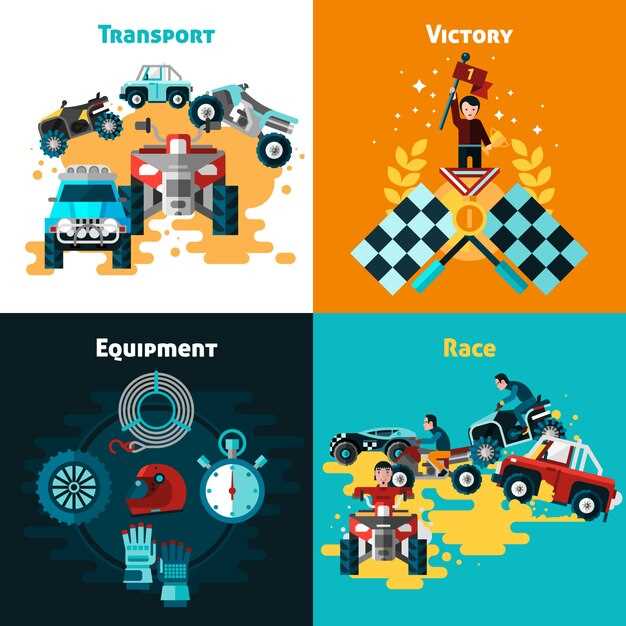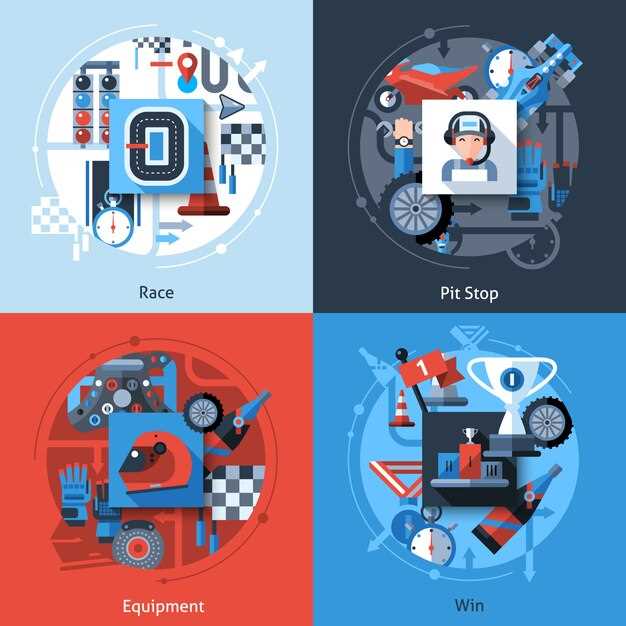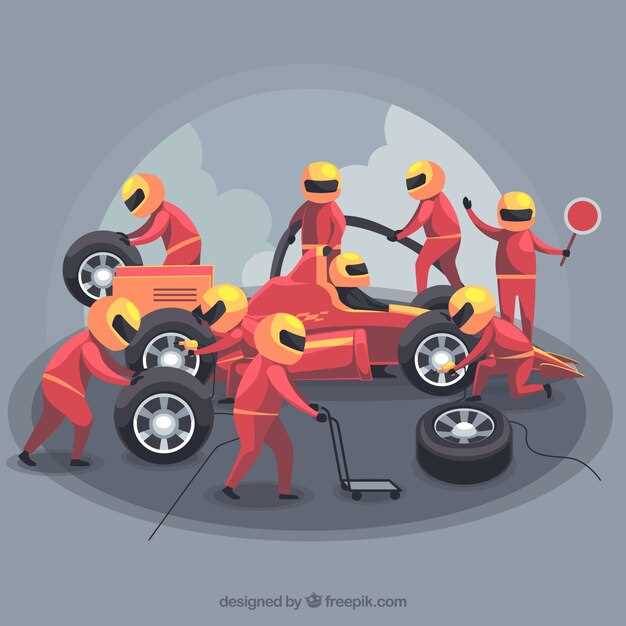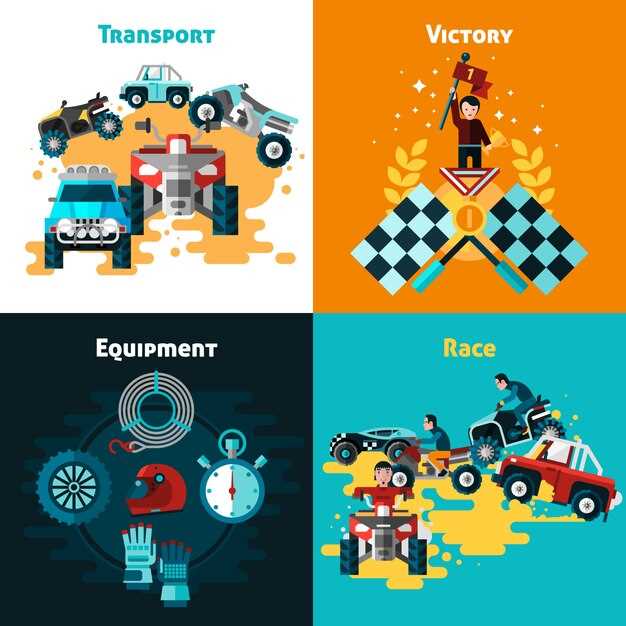Practice smooth steering inputs. This technique significantly enhances your control of the vehicle while cornering at high speeds. Focus on using small, gradual movements rather than abrupt changes. This will lead to better traction and maintain your racing line effectively.
Prioritize your braking technique. Master the art of threshold braking, which involves applying maximum brake pressure without locking the wheels. This allows you to decelerate efficiently while maintaining steering control. Aim to practice this technique in various conditions to build confidence and reliability.
Understand the dynamics of weight transfer. Acknowledge how acceleration, braking, and cornering affect your car’s balance. Use this knowledge to adjust your driving style; for instance, during braking, shift your weight forward to enhance front grip, while accelerating, shift it back to improve rear traction.
Learn to read the track. Identify the best racing lines by observing the surface conditions and learning where grip levels vary. Focus on visual cues that indicate cornering speeds and apex points. This skill allows for optimal speed navigation through each section of the track.
Finally, refine your throttle control. Smooth application of the throttle can prevent wheelspin and maintain momentum. Practice modulating your input to the pedals, allowing for greater control on exit from corners. This technique can significantly reduce lap times and improve overall performance.
Understanding Racing Lines for Maximum Speed

Prioritize the racing line, as it represents the quickest path around a track. Focus on the apex of the corner, where the car should be closest to the inside edge. Enter the corner wide, then steer towards the apex, allowing for better acceleration out of the turn.
Observe and memorize the ideal racing lines during practice sessions. Each corner demands specific techniques. For instance, practice trail braking, which helps maintain speed while turning by shifting weight to the front of the car. This technique enhances grip and control.
Recognize the different types of corners: tight, medium, and sweeping. Adjust your approach based on their characteristics. For tight corners, compromise speed for a smoother line; for sweeping corners, take a wider approach to carry more speed throughout.
| Corner Type | Recommended Approach | Key Technique |
|---|---|---|
| Tight | Wider entry, late apex | Trail braking |
| Medium | Balanced entry, mid-apex | Throttle modulation |
| Sweeping | Gentle entry, early apex | Accelerate smoothly |
Adjust your line to factor in tire wear and weather conditions. Experiment with different approaches to discover your preferred racing line. Consistent practice leads to better intuition about where your car excels.
Lastly, constantly analyze your performance data. Use telemetry to assess your speed at various points on the track. Understanding where you gain or lose time enables you to fine-tune your racing line effectively.
Braking Techniques: When and How to Slow Down

Apply your brakes smoothly and progressively. This reduces the risk of losing control and ensures better stability during deceleration. Avoid slamming the brakes unless it is an emergency, as sudden braking can cause skidding.
Understanding Brake Zones
Familiarize yourself with brake zones on the track. Each corner will have an optimal point where you should begin slowing down. Learn to recognize visual markers, such as cones or track features, that indicate when to start braking. Adjust your braking point based on the car’s speed and track conditions.
Threshold Braking
Master threshold braking, which involves applying maximum braking force without locking the wheels. This technique maximizes deceleration while maintaining control. Use a combination of foot pressure and modulating the brake pedal to find the perfect balance. Practice this technique to become proficient and confident in its execution.
Throttle Control: Balancing Acceleration and Traction

Master smooth throttle application to achieve optimal acceleration while maintaining traction. Apply pressure gradually rather than abruptly; this helps prevent wheel spin, especially in low-grip conditions. Start with a light touch, increasing throttle progressively as your car stabilizes through corners.
Understanding Traction Limits
Know your car’s limits. Each vehicle has a unique threshold where acceleration begins to overcome grip. Familiarize yourself with this boundary by conducting practice runs. Focus on feeling the car’s response; if it begins to slide, reduce throttle input. This feedback is invaluable for improving your control.
Techniques for Different Conditions
Adjust your throttle techniques based on track conditions. On a wet surface, reduce throttle input further and slow down your responses to maintain grip. Conversely, dry track surfaces allow for more aggressive throttle application. Experiment during practice to find the sweet spot that balances speed and traction for your specific car.
Mastering Cornering: Entry, Apex, and Exit

Begin your approach by reducing speed before entering the corner. Shift your weight forward and apply smooth brake pressure to maintain vehicle stability. Aim to brake in a straight line, allowing the car to remain balanced while preparing for the turn.
As you reach the entry point, start turning the steering wheel. Look where you want to go, not just at the corner itself. This helps in positioning the car accurately for the best trajectory. Keeping a steady throttle can aid in maintaining grip as you begin to navigate the curve.
Reaching the apex marks a crucial moment. Aim for the innermost point of the corner. This is where you can accelerate smoothly while transitioning from steering to throttle application. Keep the steering input consistent to maintain control. Watching the road ahead as you approach the apex will help anticipate the exit.
For the exit, gradually unwind the steering wheel and increase throttle once you pass the apex. This allows for a quicker exit speed. Be mindful of the track’s edge; fighting against the car’s tendency to oversteer will ensure better control. Accelerate smoothly to maximize speed out of the corner.
Practice these steps consistently. Refining your technique in cornering can lead to improved lap times and a more enjoyable driving experience on the track.
Using Racing Simulators for Skill Development
Invest in a high-quality racing simulator to enhance your skills. Look for platforms that offer realistic physics and a variety of cars and tracks. Brands like iRacing, Assetto Corsa, and Gran Turismo provide rich experiences that closely mimic real-world driving conditions.
Practice with Purpose
Set specific goals for each session. Focus on braking techniques, cornering styles, or throttle control. Use telemetry data from the simulator to analyze your performance. Track your lap times, tire wear, and fuel consumption to identify areas for improvement.
Engage with the Community
Join online communities and forums dedicated to racing simulators. Participate in competitive leagues to test your skills against others. Engage in discussions about techniques, setups, and strategies. Collaborate with other aspiring drivers to share insights and learn from each other.
Feedback and Data Analysis: Learning from Performance Metrics
Regularly review telemetry data after each session. Analyze parameters such as lap times, throttle position, brake pressure, steering angles, and tire temperatures. Use these metrics to identify your strengths and weaknesses on the track.
Key Metrics to Analyze
- Lap Times: Break down your lap times into sections. Identify which sectors are slower and why.
- Throttle Position: Look for patterns in acceleration. Evaluate if you’re applying throttle too early or too late out of corners.
- Brake Performance: Analyze how much brake pressure you’re using and the points where you apply it. Adjust for optimal braking efficiency.
- Corner Entry and Exit Speeds: Compare your entry and exit speeds to better understand cornering technique.
Implementing Changes Based on Feedback
Once you identify performance gaps, create a plan. Focus on one aspect of your driving at a time. For instance, if corner exits are consistently slow, enhance your acceleration technique by practicing with various throttle applications and exit points.
Consult with coaches or experienced peers for additional insights. They can offer perspectives that your data may not reveal. Use their feedback alongside your metrics for a rounded view of your performance.
Maintain a log of your findings. Document your changes and the results. This practice builds a road map for continual improvement and helps in recognizing patterns over time.
Practicing Car Control in Various Weather Conditions
When driving in rain, reduce speed and increase following distance. Wet surfaces cut down tire traction, making it easier to lose control. Start practicing in a safe area where you can experience how your vehicle reacts to smooth throttle inputs and gentle steering adjustments.
- Hydroplaning Awareness: Recognize the signs of hydroplaning. If your car begins to slide, ease off the gas and steer gently in the direction you want to go.
- Braking Technique: Use threshold braking–applying the brakes just before locking the wheels to maintain control.
Snow and ice require a different approach. Engage in slow, deliberate movements to avoid skids. Focus on maintaining momentum when driving uphill and downhill.
- Traction Control: Use the car’s traction control settings if available. This can help maintain grip on slippery surfaces.
- Steering Control: Keep your hands at the 9 and 3 positions on the wheel for better responsiveness.
Foggy conditions can be more dangerous than expected. Keep your speed low and use lower beam headlights to improve visibility.
- Distance Management: Increase your following distance significantly. It will give you more time to react to any obstacles.
- Sound Awareness: Turn off loud music and stay alert to surrounding sounds. This can help you notice other vehicles earlier.
Practice these techniques regularly across different weather conditions. Doing so will build your confidence and improve your reflexes, crucial for any aspiring racing driver.
Studying Competitors: Learning from the Experts
Analyze your competitors’ racing styles. Focus on the top performers in your class. Observe their lines, braking points, and throttle application. This insight helps refine your technique.
Create a watching list of races featuring these drivers. Look for both live events and recorded sessions. Pay attention to their decision-making under various conditions.
- Identify Key Drivers: Select five to ten drivers known for their skills. Study them consistently.
- Breakdown Footage: Use video analysis tools to slow down and annotate key sections. Look at cornering habits and overtaking maneuvers.
- Note Vehicle Setup: Research each driver’s car setup. Suspension settings, tire choices, and aerodynamic adjustments impact performance.
Attend local races or practice sessions where these drivers compete. Engage with them; many are open to sharing insights. Join relevant forums or social media groups to discuss techniques and strategies.
- Practice Derived Techniques: Incorporate newly learned tactics into your practice sessions. Experiment and refine them.
- Track Feedback: After implementing new techniques, gather feedback from coaches or peers. Adjust based on constructive criticism.
- Repeat the Process: Continuously watch competitors, update your techniques, and engage in ongoing learning. Racing is a dynamic sport.
By studying competitors, you not only enhance your skills but also develop a deeper understanding of racing strategies. Keep pushing yourself to learn and adapt. Success on the track depends on it.
Fitness and Mental Focus: Preparing for Races
Incorporate strength and endurance training into your weekly routine. Aim for at least three days of intense workouts focusing on core stability, upper body strength, and leg power. This not only enhances control over the vehicle but also reduces fatigue during long races.
Cardio workouts, such as running or cycling, should complement strength training. Perform cardio for at least 30 minutes, four times a week. High-intensity interval training (HIIT) is particularly beneficial, raising heart rate rapidly and improving recovery times between intense racing maneuvers.
Nutrition plays a key role in physical preparation. Focus on a balanced diet rich in carbohydrates, lean proteins, and healthy fats. Hydration is paramount; drink water throughout the day and consider electrolyte-rich drinks before and during races. A sample daily meal plan can guide your eating habits:
| Meal | Food |
|---|---|
| Breakfast | Oatmeal with berries and nuts |
| Lunch | Grilled chicken salad with quinoa |
| Snack | Greek yogurt with honey |
| Dinner | Baked salmon with steamed vegetables |
| Pre-Race | Banana and a protein shake |
Mental focus is equally critical. Regularly practice visualization techniques. Spend time imagining yourself on the track, executing precise turns and reacting swiftly. This reinforces confidence and prepares your mind for race scenarios.
Incorporate mindfulness exercises or meditation daily. Even ten minutes can help clear your mind, reduce anxiety, and improve concentration. Breathing exercises can also aid in maintaining calm during high-pressure moments on race day.
Lastly, ensure adequate rest. Aim for 7-9 hours of sleep each night. Quality sleep enhances recovery, sharpens reaction times, and keeps you alert during races. Prioritizing fitness and mental focus sets the foundation for racing success.
Vehicle Setup Basics: Adjusting Settings for Optimal Performance
Adjust tire pressure according to the track conditions. Lower pressure enhances grip on rough surfaces, while higher pressure reduces rolling resistance on smooth tracks. Always measure pressure when tires are cold to ensure accuracy.
Adjust the suspension settings to match the track profile. Softer suspension provides better grip on bumpy circuits, while stiffer settings improve response on flat tracks. Test different settings during practice sessions to find the right balance.
Check the alignment of your vehicle. Proper toe and camber angles improve tire contact with the road, resulting in better handling. Use precise measurements to ensure all wheels are aligned correctly, enhancing stability during high-speed turns.
Modify the brake bias to suit your driving style and track layout. Shifting the bias toward the front increases stopping power for heavy braking zones, while a rearward bias allows for better control during cornering. Fine-tune this setting for optimal performance.
Adjust gear ratios based on the track layout. Shorter gears improve acceleration on tight tracks, while longer gears are beneficial on high-speed circuits. This setup can maximize engine performance, allowing for quicker lap times.
Lastly, consider aerodynamics. Adjust the front and rear wing angles to optimize downforce for the specific track. More downforce increases grip but may reduce top speed, while less downforce enhances speed but can affect cornering stability. Experiment to find the ideal balance for your setup.
Understanding Race Strategies: From Start to Finish
Focus on your grip during the start. A good launch relies on finding the balance between power and traction. Monitor the tire temperature and track surface to make the most of your start. Aim for a clean getaway and avoid wheel spin.
As you navigate the opening laps, prioritize positioning. Keep an eye on competitors’ movements and make calculated decisions. Use slipstreams effectively on long straights to gain speed while being aware of braking zones ahead.
Pitting and Tire Management
Plan your pit stops wisely. Analyze tire degradation and fuel levels to determine the best time for a pit. A well-timed stop can enhance your overall race pace. Choose the right tire compound based on track conditions and weather forecasts.
Minimize time spent in the pit lane. Practice quick tire changes and refueling to maximize your efficiency. Prioritize communication with your pit crew to synchronize your strategies smoothly.
Defending and Overtaking Techniques
While defending your position, maintain a predictable line and avoid sudden moves. Anticipate your opponent’s actions and position your car to block potential overtakes without compromising your speed.
When overtaking, assess the situation thoroughly. Look for opportunities during braking zones and exit corners. Execute overtakes decisively but safely, ensuring you have enough space and control to avoid collisions.
Video:
TOP 5 Driving Techniques Only the BEST F1 Drivers Master
TOP 5 Driving Techniques Only the BEST F1 Drivers Master by Cameron Das Racing 34,303 views 1 year ago 8 minutes, 49 seconds
Q&A:
What are the key techniques a new racing driver should focus on to improve their skills?
Aspiring racing drivers should concentrate on several fundamental techniques to enhance their abilities. First, mastering throttle control is crucial, as it allows drivers to manage acceleration smoothly. Next, understanding proper braking techniques helps maintain control while reducing speed effectively. Cornering skills, including the racing line and apex clipping, are also vital for maintaining speed during turns. Additionally, learning to read the track and anticipate changes will help drivers adapt their strategies throughout the race. Lastly, practicing mental focus and reaction times can significantly improve performance under pressure.
How does understanding tire management impact racing performance?
Tire management is a significant factor in racing performance because tire conditions directly affect grip and handling. Drivers must learn how to conserve tires during a race to ensure optimal performance throughout the entirety. This includes adjusting driving style to avoid excessive wear, understanding tire temperatures, and recognizing when to pit for new tires. By managing tires properly, drivers can maintain speed and control, allowing them to perform at their best, especially in longer races where maintaining tire integrity is critical.
Can you explain the importance of racecraft in competitive racing?
Racecraft refers to the skills and strategies a driver employs during competition. It encompasses aspects like overtaking, defending a position, and negotiating with other cars on the track. A driver with strong racecraft can make calculated decisions, such as when to take risks and when to be conservative. Having good racecraft allows a driver to not only position themselves advantageously on the track but also to anticipate competitors’ moves. Therefore, developing racecraft is essential for increasing competitiveness in any racing environment.
What role does physical fitness play in racing performance?
Physical fitness is critical for racing drivers as it impacts their ability to handle the physical demands of a race. High levels of endurance and strength help drivers maintain focus and control over long periods, especially during intense situations. Core stability is also vital, as it aids in handling G-forces experienced while cornering and braking. Additionally, drivers benefit from mental fitness, allowing them to stay sharp and react quickly to changing race conditions. Overall, being physically fit contributes significantly to a driver’s performance on the track.
How can aspiring racers practice and develop their skills outside of actual racing events?
Aspiring racers can develop their skills through various methods outside of official races. One effective way is by using racing simulators, which allow drivers to practice in a controlled environment and refine their techniques. Additionally, participating in track days or karting events can provide valuable hands-on experience. Studying video footage of their own performances and professional races can also help them identify areas for improvement. Lastly, engaging with other racers and instructors for feedback and tips is beneficial for skill enhancement.


